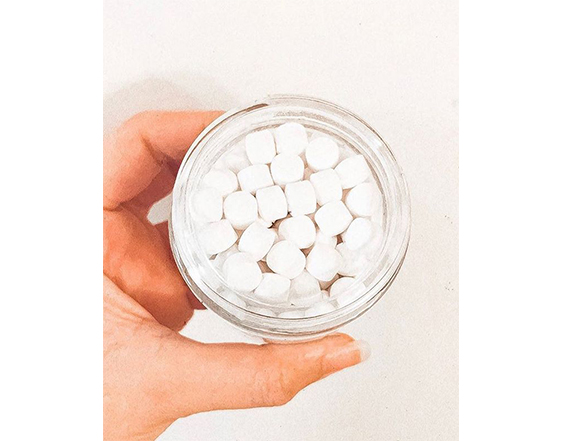With the rapid development of contemporary society, a new trend has emerged in oral care——toothpaste tablets. These small, convenient, and eco-friendly alternatives to traditional toothpaste have gained popularity. They are especially attractive to individuals who seek a sustainable and efficient oral hygiene routine. In this blog post, we will delve into the mechanism, proper usage, benefits, and drawbacks of toothpaste tablets. Read on for more information.
Introduction
In general, toothpaste tablets are solid and compacted forms of toothpaste. They dissolve and foam up when they are chewed or crushed between the teeth. Toothpaste tablets are typically made from natural ingredients including baking soda, silica, and essential oils, and come in various flavors.
Toothpaste tablets work on the same principle as traditional toothpaste, aiming to clean and protect teeth and gums. When the tablet is chewed or crushed, it releases its active ingredients, which mix with saliva to form a foam. This foam can help a lot in the removal of plaque, stains, and bacteria from the teeth.
Usage
1. Wet your toothbrush bristles with water.
2. Pop a toothpaste tablet into your mouth and chew it until it forms a paste. Alternatively, you can crush it with your teeth or between your fingers.
3. Get the toothpaste-coated bristles wet and brush your teeth in circular motions for at least two minutes.
4. Rinse your mouth thoroughly and spit out the foam.
5. Store the remaining toothpaste tablets in a dry and cool place, away from moisture.
Benefits
1. Portability
Toothpaste tablets are compact and lightweight, making them ideal for travel. They eliminate the need for carrying bulky toothpaste tubes. According to the TSA’s 3-1-1 liquids rule, conventional toothpaste is considered a kind of liquid. Limitations show that each passenger can only carry one quart-size bag of liquids, gels, and aerosols. Consequently, swapping out your tube for tablets frees up space for other precious elixirs in your carry-on and checked bags. In addition, it helps reduce the risk of dealing with a toothpaste tube squishing open in your luggage.
2. Environmental Friendliness
As the survey reveals, Americans toss out more than 400 million toothpaste tubes every year. However, these tubes end up in the landfill, since most of them are made of a non-recyclable aluminum-plastic composite. Unlike traditional toothpaste tubes, toothpaste tablets often come in recyclable packaging or even plastic-free options. By using toothpaste tablets, you can significantly reduce plastic waste and contribute to a greener planet.
3. Precise Dosage
Each toothpaste tablet contains a predetermined amount of toothpaste, ensuring that you use the right amount for effective cleaning. This helps prevent both underuse and overuse of toothpaste, leading to better oral health. You may have had the terrible experience of seeing dried clumps of toothpaste magically appear in the sink. This is often attributed to the overused toothpaste, which falls out of your sight. But if you choose to use toothpaste tablets, there are no more goopy messes.
4. Freshness and Flavor
Toothpaste tablets are available in a wide range of flavors, such as blueberry, mint and wintergreen. Thus, they will provide a refreshing and pleasant brushing experience for you. They leave a clean and minty feeling in your mouth, promoting long-lasting freshness.
5. Healthy Ingredients
Many toothpaste tablet brands prioritize natural ingredients, so you are less likely to find preservatives or parabens. There is also a plethora of gluten-free, vegan, and cruelty-free options to match your lifestyle. Furthermore, some tablets contain fluoride, which helps strengthen your enamel and protect your teeth against cavities.
Drawbacks
1. Initial Adaptation
Some users may find it initially challenging to switch from traditional toothpaste to toothpaste tablets. Chewing or crushing the tablet to form a paste requires a different brushing technique. So, it may take a few tries to get used to it.
2. Availability
Toothpaste tablets may not be as readily available as traditional toothpaste in all stores. However, with the growing popularity, more brands are expanding their distribution to meet the demand.
3. Lack of Research
Up to now, there exists little research to compare the effectiveness of toothpaste tablets to traditional toothpaste. If you have concerns before transitioning to tablets, talk to your dentist to monitor your oral health.
4. Cost
When you choose sustainability, you might have to make some trade-offs. Take the cost into consideration before you make the switch to tooth tablets. It can cost around $30 for a four-month supply of tablets. You can compare that to $3-6 for a 6 oz tube of toothpaste which lasts four months or even longer.
Toothpaste tablets offer a convenient, eco-friendly, and effective alternative to traditional toothpaste. Admittedly, the initial adaptation period and availability challenges are unavoidable issues. However, their benefits of portability, environmental friendliness, precise dosage, freshness, and healthy ingredients make them a compelling choice. By making a switch to toothpaste tablets, you can contribute to a sustainable future while maintaining excellent oral hygiene.
(Note: This blog post contains general information and should not replace professional dental advice. Please consult your dentist for personalized recommendations.)

